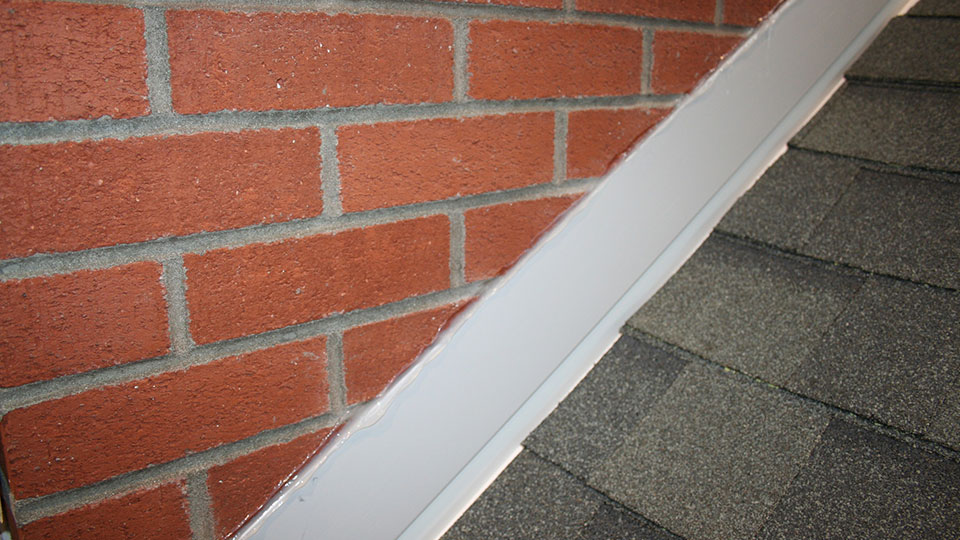Install Roof Flashing Against Brick Wall

Roofing God: I currently had a same situation where my sunroom was attached and flashed to the side of my brick wall on the house. I had a roofer suggest the same thing re: cutting into the brick to insert the flashing instead of what the builder did which was lay the flashing flat against the brick and then caulk the flashing. A Civil Contract Georgette Heyer Pdf Reader. My question is should I seal the brick wall above where my roofer is going to fix the problem. Would that help in repelling water?
Your talking a 15 x 6 foot section of brick. Thanx for your help Actually: anybody can ring in here that knows if sealing my brick wall is a good idea?? Thanx, tallpaw. In response to tallpaw's question (though it's way too late to help him perhaps). From what I've read, sealing is usually only a short term solution to a water sepage problem on a particular wall of a brick house. The usual condensation that forms behind a brick wall should make its way out through weep holes and through the porous brick itself.
It is not uncommon, especially in two story and side split houses to have a roof that butts against a wall, as shown in Figure 1. If the flashing is being installed is against a brick wall then the flashing should sit against the wall and have a layer of asphalt cement between it and the wall. Stucco presents its own. Metal roof flashing can be use to seal gaps between roof walls. It is commonly used in two-story and side-split houses.
They do make brick sealants, however, which are classified as films and penetrants. Films do not allow water trapped inside the brick to evaporate out the exterior side. Penetrants do. Here's a good link (about half way down the page).
Microsoft Office 2003 Download Torrent Iso here. Install step and kick-out flashing at all roof-wall intersections to protect walls from water intrusion and install boot or collar flashing at all roof penetrations to protect roofs from leaks. • Install corrosion-resistant flashing pieces that are overlapped shingle fashion. • Extend step flashing at least 4 inches up the wall from the roof deck and at least four inches out along the roof deck (IRC 2015) and integrate the flashing with the drainage plane above (for example, overlap house wrap over it). Advan Vanbook A1n70t Driver Win7. • If metal, the flashing should be made of galvanized steel at least 0.019-inches thick (IRC 2015). • Install roof felt prior to installing the step and kick-out flashing. • Install house siding over the step flashing, ending at least one inch above the roof surface.
• Install shingles over the portion of step flashing on the roof. • When installing metal or rubber membrane roofs, use continuous flashing rather than pieces of step flashing. • Install kick-out flashing at the end of a roof-wall intersection to divert water away from the wall and into gutters. Ensure that the kick-out flashing is large enough to handle expected storm water flows. • Install boot or collar flashings around all roof penetrations and properly integrate with roof membranes and shingles above and below the penetration. See the for related codes and standards requirements, and criteria to meet national programs such as DOE’s Zero Energy Ready Home program, ENERGY STAR Certified Homes, and Indoor airPLUS. Deluging rains can pour thousands of gallons of water onto a home’s roof in a single storm.
In multi-level house designs where roofs intersect walls, much of this water is channeled along the wall to a gutter. If sidewall flashing is lacking or inadequate, water runoff can get inside the wall and cause serious damage. In big storm events, rainwater can often overflow the gutter and stream down the walls.
Diverters are sometime fashioned onsite in an attempt to direct this water into the gutters. If undersized, these diverters are not very helpful. If not properly integrated with the existing housewrap and cladding, they can do more harm than good by allowing water inside the wall cavities. The result can be significant damage to wall sheathing, framing, and insulation, and mold inside the wall cavities. While older wood siding would show evidence of this water intrusion by peeling paint, new wall claddings like fiber cement, vinyl siding, and brick veneer can mask the evidence for years. Anywhere roof sections adjoin wall sections, step flashing should be used to keep water from entering the walls, and kick-out diverters should be used to direct the rainwater into rain gutters where it can be carried away from the structure.